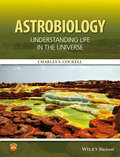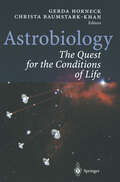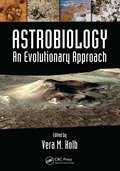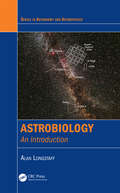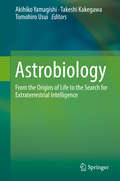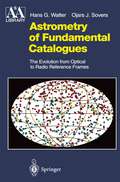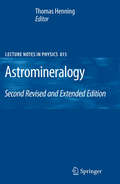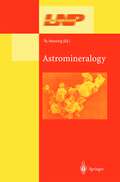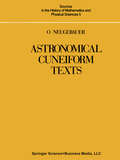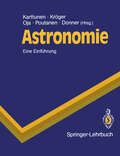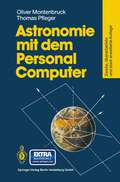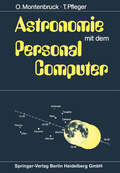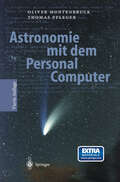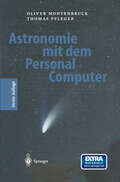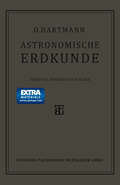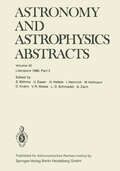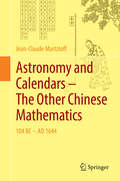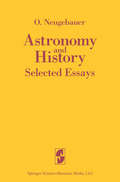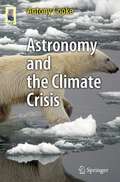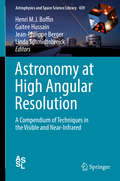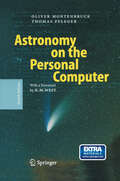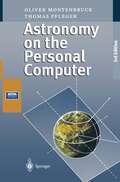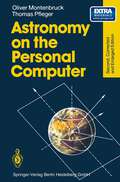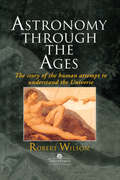- Table View
- List View
Astrobiology: Understanding Life in the Universe
by Charles S. CockellAstrobiology is an interdisciplinary field that asks profound scientific questions. How did life originate on the Earth? How has life persisted on the Earth for over three billion years? Is there life elsewhere in the Universe? What is the future of life on Earth?Astrobiology: Understanding Life in the Universe is an introductory text which explores the structure of living things, the formation of the elements for life in the Universe, the biological and geological history of the Earth and the habitability of other planets in our own Solar System and beyond. The book is designed to convey some of the major conceptual foundations in astrobiology that cut across a diversity of traditional fields including chemistry, biology, geosciences, physics and astronomy. It can be used to complement existing courses in these fields or as a stand-alone text for astrobiology courses. Readership: Undergraduates studying for degrees in earth or life sciences, physics, astronomy and related disciplines, as well as anyone with an interest in grasping some of the major concepts and ideas in astrobiology.
Astrobiology: The Quest for the Conditions of Life
by Gerda Horneck Christa Baumstark-KhanThis book bridges a gap in the literature by bringing together leading specialists from different backgrounds. It addresses the specific need for a readable book on this very interdisciplinary and new topic at research level.
Astrobiology: An Evolutionary Approach
by Vera M. KolbAstrobiology: An Evolutionary Approach provides a full course in astrobiology with an emphasis on abiogenesis and evolution. The book presents astrobiology both as a developing science and as the science of the future.The origins of life and the possibility of life elsewhere continues to be a subject of scientific and philosophical examination. The
Astrobiology: An Introduction (Series In Astronomy And Astrophysics Ser.)
by Alan LongstaffAstrobiology is a multidisciplinary pursuit that in various guises encompasses astronomy, chemistry, planetary and Earth sciences, and biology. It relies on mathematical, statistical, and computer modeling for theory, and space science, engineering, and computing to implement observational and experimental work. Consequently, when studying astrobio
Astrobiology: From the Origins of Life to the Search for Extraterrestrial Intelligence
by Akihiko Yamagishi Takeshi Kakegawa Tomohiro UsuiThis book provides concise and cutting-edge reviews in astrobiology, a young and still emerging multidisciplinary field of science that addresses the fundamental questions of how life originated and diversified on Earth, whether life exists beyond Earth, and what is the future for life on Earth. Readers will find coverage of the latest understanding of a wide range of fascinating topics, including, for example, solar system formation, the origins of life, the history of Earth as revealed by geology, the evolution of intelligence on Earth, the implications of genome data, insights from extremophile research, and the possible existence of life on other planets within and beyond the solar system. Each chapter contains a brief summary of the current status of the topic under discussion, sufficient references to enable more detailed study, and descriptions of recent findings and forthcoming missions or anticipated research. Written by leading experts in astronomy, planetary science, geoscience, chemistry, biology, and physics, this insightful and thought-provoking book will appeal to all students and scientists who are interested in life and space.
Astrometry of Fundamental Catalogues: The Evolution from Optical to Radio Reference Frames (Astronomy and Astrophysics Library)
by Hans G. Walter Ojars J. SoversCelestial fundamental catalogues are a prerequisite for the determination of absolute positions and motions in space. Presently, positional astrometry is at the watershed between classical fundamental catalogues, based on moving reference stars, and modern catalogues, based on extragalactic reference objects with non-measurable motion. This book addresses the concepts and methods of the respective construction techniques leading to the stellar frame of the FK5 (fifth fundamental catalogue) and to the newly adopted extragalactic radio reference frame, ICRF (international celestial reference frame), with its extension to optical wavelengths by the Hipparcos Catalogue. While principal outlines of meridian circle observations are given, emphasis is put in some detail on the VLBI technique as applied to astrometry, and to the observational techniques used in the Hipparcos mission, including the tie of the originally non-anchored rigid Hipparcos sphere into the ICRF.
Astromineralogy (Lecture Notes in Physics #815)
by Thomas HenningAstromineralogy deals with the science of gathering mineralogical information from the astronomical spectroscopy of asteroids, comets and dust in the circumstellar environments in general. This field has received a tremendous boost with the reliable identification of minerals by the Infrared Space Observatory. The first edition of this book, published in 2003, was the first comprehensive and coherent account of this exciting field. Data obtained in the meantime with the Spitzer Infrared Space Telescope, the stardust mission to the comet 81P / Wild 2, and with the Cassini mission, together with progress in ground-based observations and laboratory astrophysics form the basis for this updated and widely extended second edition.Beyond addressing the specialist in the field, the book is intended as a high-level but readable introduction to astromineralogy for both the nonspecialist researcher and the advanced student.
Astromineralogy (Lecture Notes in Physics #609)
by Thomas HenningAstromineralogy deals with the science of gathering mineralogical information from the astronomical spectroscopy of asteroids, comets and dust in the circumstellar environments in general. It is only recently, however, that this field has received a tremendous boost with the reliable identification of minerals by the Infrared Space Observatory. This book is the first comprehensive and coherent account of this exciting field. Beyond addressing the specialist in the field, the book is intended as a high-level but readable introduction to astromineralogy for both the nonspecialist researcher and the advanced student.
Astronomical Cuneiform Texts: Babylonian Ephemerides of the Seleucid Period for the Motion of the Sun, the Moon, and the Planets (Sources in the History of Mathematics and Physical Sciences #5)
by O. NeugebauerTHE MOON IX PREFACE TO THE SPRINGER EDITION When this collection of Babylonian astronomical purpose of column of the lunar ephemerides (by texts was published in 1955 (a date omitted by Aaboe) and the explanation of the method of computing the eclipse text ACT No. 6o (by Hamilton mistake from the title page), it contained all texts of this type that I could lay my hands on. As was to be and Aaboe). Some of these advances I have tried to incorporate into my History of Ancient Mathematical expected, the past 25 years provided more fragments, identified by A. Sachs and A. Aaboe in the British Astronomy (1975), which should be used as a guide to Museum and listed below. Also, some new joins the more recent literature. could be made and some errors of mine corrected. My sincerest thanks go to Springer-Verlag for Nevertheless, I think one still can consider the making this work again available to students of material of 1955 to be representative of what has been ancient astronomy. The Institute for Advanced preserved of the mathematical astronomy of the Study, which together with Brown University has Seleucid period. supported my work for more than four decades, has In the meantime, far more progress has been made graciously given its permission for this reprint. in our understanding of Babylonian astronomy, mainly by the publications of Aaboe, Hamilton, Maeyama, Sachs, van der Waerden, and others. As an Princeton 0.
Astronomie: Eine Einführung (Springer-Lehrbuch)
by Hannu Karttunen Siegfried A. Marx Pekka Kröger Holger H. Lehmann Heikki Oja Markku Poutanen Karl J. DonnerAstronomie gibt eine ausgezeichnete, reich illustrierte Darstellung aller klassischen und modernen Teilgebiete dieser Wissenschaft. Dabei wird ebenso großer Wert auf die faszinierenden Beobachtungsergebnisse und die zugrundeliegenden physikalischen Vorgänge gelegt. Das Buch eignet sich damit gleichermaßen als Begleiter zur Astronomie-Vorlesung wie als Fundgrube und Nachschlagewerk für jede(n) Astronomiebegeisterte(n). "... ein so modernes Buch, wie es kaum ein einzelner Autor vorlegen könnte." #Sterne und Weltraum (2/89)(zur englischen Ausgabe)#1
Astronomie mit dem Personal Computer
by Oliver Montenbruck Thomas PflegerDiese lang erwartete Neuauflage des erfolgreichen Buches von O. Montenbruck und T. Pfleger enthält nunmehr auch je ein Kapitel zur Störungsrechnung und zur Berechnung von physischen Ephemeriden der großen Planeten und der Sonne. Gänzlich neu bearbeitet ist auch die dem Buch beigelegte Diskette. Das Buch bietet dem Leser eine Vielzahl von Programmen und Anleitungen zur Zeit- und Kalenderrechnung und zur Behandlung des Zweikörperproblems. Die Kapitel sind thematisch gut umrissen und schließen mit einem zugehörigen Hauptprogramm, was die Nutzung als praktisches Handbuch erleichtert. Die astronomischen und numerischen Grundlagen werden ausreichend im Text zur Verfügung gestellt.
Astronomie mit dem Personal Computer
by Oliver Montenbruck Thomas PflegerAstronomie mit dem Personal Computer stellt einem weiten Interessentenkreis vom engagierten Hobbybeobachter über den Studenten bis zum Dozenten leistungsfähige, gut strukturierte Pascal-Programme zur Verfügung. Sie reichen von der Berechnung von Koordinatentransformationen oder genauen Planetenpositionen bis zur Vorhersage von Sternbedeckungen und Sonnenfinsternissen oder der Bahnbestimmung und der Photoplattenvermessung. Dazu werden das Problem, die numerische Lösung und das Programm ausführlich vorgestellt und die Ergebnisse diskutiert. Der modulare Aufbau der auf Diskette erhältlichen Pascal-Programme (Bestellkarte liegt bei) macht diese vielfältig einsetzbar und erlaubt es, damit weitere Software zur Lösung eigener Aufgaben zu entwickeln.
Astronomie mit dem Personal Computer
by Oliver Montenbruck Thomas PflegerAstronomie mit dem PC vermittelt dem Leser eine fundierte Einführung in die Welt der himmelsmechanischen Berechnungen, die für die astronomische Beobachtungspraxis von besonderer Bedeutung sind.Von den theoretischen Grundlagen der Astronomie und Numerik bis zur Erstellung schneller und präziser Anwendungsprogramme vermittelt das Buch die notwendigen Kenntnisse und Softwarelösungen für die Bestimmung und Vorhersage von:- Positionen der Sonne, des Mondes und der Planeten- Auf- und Untergangszeiten- physischen Ephemeriden der Sonne und der großen Planeten- Kometen- und Kleinplanetenpositionen (mit Störungen)- Mondphasen- Zentrallinie und lokalen Umständen von Sonnenfinsternissen - Sternbedeckungen durch den Mond- Bahnelementen aus drei Beobachtungen (auch mehrere Lösungen)- Koordinaten aus Himmelsaufnahmen. Die Verwendung der weitverbreiteten objektorientierten Programmiersprache CC++ ermöglicht die effiziente Realisierung eigener Anwendungen auf der Basis einer leistungsfähigen Modul-Bibliothek. Die Begleit-CD enthält neben den vollständigen, ausgiebig dokumentierten und kommentierten Quelltexten auch die ausführbaren Programme - damit können Leser ohne Programmierkenntnisse alle im Buch beschriebenen Programme ebenfalls nutzen. Zusätzlich befinden sich zwei Sternkataloge (Position und Proper Motion Katalog und Zodialkatalog) sowie die Lowell-Datenbank aktueller Kleinplaneten-Bahnelemente auf der CD, die den Nutzwert der entsprechenden Programme weiter erhöhen. Die vorliegende 4. Auflage stellt, neben einigen Überarbeitungen der Texte und Bilder, die ausführbaren Programme für die Betriebssysteme Windows 98/2000/XP und LINUX sowie die akualisierten Kataloge und Datenbanken zur Verfügung.
Astronomie mit dem Personal Computer
by Oliver Montenbruck Thomas PflegerDie letzten Jahre brachten eine kontinuierliche Steigerung der Leistungsfähigkeit kleiner Computer bei gleichzeitigem Sinken ihrer Preise. Demzufolge stehen heute vielen an der Astronomie Interessierten solche Geräte zur Verfügung. Der Wunsch, den Computer auch für astronomische Berechnungen heranzuziehen, ist nahelie gend. Welche konkreten Vorteile können sich durch den Einsatz des eigenen Rech ners ergeben, zumal man die wichtigsten Daten, die zur Beobachtung benötigt werden, doch ebensogut in einem der zahlreichen Jahrbücher nachschlagen kann? 1. 1 Anwendungsbeispiele Betrachten wir zunächst einmal die Berechnung der Auf- und Untergangszeiten von Sonne und Mond. Von einem Beobachtungsort zum anderen ergeben sich schnell Zeitdifferenzen, die man nicht mehr vernachlässigen will. In einem Jahrbuch werden die Auf-und Untergangszeiten aber in der Regel nur für einige wenige Orte angegeben. Man ist deshalb häufig auf eine Interpolation oder die Anwendung von Nomogrammen angewiesen, wenn man die Zeiten für einen beliebigen Ort bestimmen möchte. Hier ist es wesentlich komfortabler und genauer, wenn der Rechner ohne zusätzliche Überlegungen direkt die gesuchten Daten liefern kann. Den umfangreichsten Teil eines Jahrbuchs bilden die seitenlangen Tafeln der Sonnen-, Mond- und Planetenpositionen. Von den dort abgedruckten Daten ist oft nur ein kleiner Teil von Interesse. Mit Hilfe von entsprechenden Programmen lassen sich die tatsächlich benötigten Werte schnell berechnen und gleichzeitig in jedem gewünschten Koordinatensystem darstellen. Noch wichtiger ist die Möglichkeit, die Bahn eines Himmelskörpers per Pro gramm selbst zu berechnen, im Fall von Kometen. Bei Neuentdeckungen sind aktuelle Ephemeriden oft gar nicht oder nur mit Verzögerungen erhältlich.
Astronomische Erdkunde
by Prof. Otto HartmannDieser Buchtitel ist Teil des Digitalisierungsprojekts Springer Book Archives mit Publikationen, die seit den Anfängen des Verlags von 1842 erschienen sind. Der Verlag stellt mit diesem Archiv Quellen für die historische wie auch die disziplingeschichtliche Forschung zur Verfügung, die jeweils im historischen Kontext betrachtet werden müssen. Dieser Titel erschien in der Zeit vor 1945 und wird daher in seiner zeittypischen politisch-ideologischen Ausrichtung vom Verlag nicht beworben.
Astronomy and Astrophysics Abstracts: Volume 42 Literature 1986, Part 2 (Astronomy and Astrophysics Abstracts #42)
by S. Böhme U. Esser H. Hefele I. Heinrich W. Hofmann D. Krahn V. R. Matas L. D. Schmadel G. ZechFrom the reviews: Astronomy and Astrophysics Abstracts has appeared in semi-annual volumes since 1969 and it has already become one of the fundamental publications in the fields of astronomy, astrophysics and neighbouring sciences. It is the most important English-language abstracting journal in the mentioned branches. ... The abstracts are classified under more than hundred subject categories, thus permitting a quick survey of the whole extended material. The AAA is a valuable and important publication for all students and scientists working in the fields of astronomy and related sciences. As such it represents a necessary ingredient of any astronomical library all over the world." Space Science Reviews #1 "Dividing the whole field plus related subjects into 108 categories, each work is numbered and most are accompanied by brief abstracts. Fairly comprehensive cross-referencing links relevant papers to more than one category, and exhaustive author and subject indices are to be found at the back, making the catalogues easy to use. The series appears to be so complete in its coverage and always less than a year out of date that I shall certainly have to make a little more space on those shelves for future volumes." The Observatory Magazine #1
Astronomy and Calendars – The Other Chinese Mathematics: 104 BC - AD 1644
by Jean-Claude MartzloffPresented from the viewpoint of the history of mathematics, this book explores both epistemological aspects of Chinese traditional mathematical astronomy and lunisolar calendrical calculations. The following issues are addressed: (1) connections with non-Chinese cultural areas; (2) the possibility or impossibility of using mathematics to predict astronomical phenomena, a question that was constantly raised by the Chinese from antiquity through medieval times; (3) the modes of representation of numbers, and in particular the zero, found in the context of Chinese calendrical calculations; and (4) a detailed analysis of lunisolar calendrical calculations. Fully worked-out examples and comparisons between the results of calculations and the content of Chinese historical calendars from various periods are provided.Traditional Chinese calendrical and mathematical astronomy consists of permanently reformed mathematical procedures designed to predict, but not explain, phenomena pertaining to astronomy and related areas. Yet, despite appearances, models of the mathematical techniques hidden behind this voluminous corpus reveal that they depend on a limited number of clear-cut mathematical structures. Although only a small fraction of these techniques have been fully studied, what is known surprisingly broadens our knowledge of the history of Chinese mathematics.Sinologists interested in the history of Chinese science, and anyone interested in the history of Chinese mathematics, the Chinese calendar, and the history of Chinese mathematical astronomy from its origin (104 BC) to its European reform (AD 1644) will find this book very useful. The present English language edition is a fully revised and updated version of the French original. Even though this is a research monograph in sinology, no particular sinological background is required, although a basic understanding of ‘concrete mathematics’ is needed.From the reviews of the French edition: This is a demanding, rigorous book to read … worth the concentrated study it requires. The rewards are not only in the details but in the general overview that …[it] provides. Joseph Dauben, EASTM, 2011...first Work in a Western language to turn to for anyone interested in the details of Chinese calendrical computations. Benno Van Dalen, ISIS, 2011 Martzloff’s careful scholarship and his overall look at the calendar beyond astronomical calculations, …, make this book a most valuable contributions to a field of increasing interest. U. D’Ambrosio, Mathematical Reviews, 2013
Astronomy and History Selected Essays
by O. NeugebauerThe collection of papers assembled here on a variety of topics in ancient and medieval astronomy was originally suggested by Noel Swerdlow of the University of Chicago. He was also instrumental in making a selection* which would, in general, be on the same level as my book The Exact Sciences in Antiquity. It may also provide a general background for my more technical History of Ancient Mathematical Astronomy and for my edition of Astronomi cal Cuneiform Texts. Several of these republished articles were written because I wanted to put to rest well-entrenched historical myths which could not withstand close scrutiny of the sources. Examples are the supposed astronomical origin of the Egyptian calendar (see [9]), the discovery of precession by the Babylonians [16], and the "simplification" of the Ptolemaic system in Copernicus' De Revolutionibus [40]. In all of my work I have striven to present as accurately as I could what the original sources reveal (which is often very different from the received view). Thus, in [32] discussion of the technical terminology illuminates the meaning of an ancient passage which has been frequently misused to support modern theories about ancient heliocentrism; in [33] an almost isolated instance reveals how Greek world-maps really looked; and in [43] the Alexandrian Easter computus, held in awe by many historians, is shown from Ethiopic sources to be based on very simple procedures.
Astronomy and the Climate Crisis (Astronomers' Universe)
by Antony CookeClimate change is acknowledged as being one of the most important areas of research today. Increasing global temperatures will impact all of us to a greater or lesser extent. From the point of view of research it is an enormously important and complex subject. However, little attention is paid to its relationship to astronomy, the sun in particular but not exclusively. Though directed at an astronomically inclined readership, and providing some less well-known astronomically related information, studies and concepts, this book will also appeal to a broader public, who need to understand the subject of climate change and learn of all the various theories and possible solutions.
Astronomy at High Angular Resolution: A Compendium of Techniques in the Visible and Near-Infrared (Astrophysics and Space Science Library #439)
by Henri M. J. Boffin Gaitee Hussain Jean-Philippe Berger Linda SchmidtobreickThis book offers an essential compendium of astronomical high-resolution techniques. Recent years have seen considerable developments in such techniques, which are critical to advances in many areas of astronomy. As reflected in the book, these techniques can be divided into direct methods, interferometry, and reconstruction methods, and can be applied to a huge variety of astrophysical systems, ranging from planets, single stars and binaries to active galactic nuclei, providing angular resolution in the micro- to tens of milliarcsecond scales. Written by experts in their fields, the chapters cover adaptive optics, aperture masking imaging, spectra disentangling, interferometry, lucky imaging, Roche tomography, imaging with interferometry, interferometry of AGN, AGN reverberation mapping, Doppler- and magnetic imaging of stellar surfaces, Doppler tomography, eclipse mapping, Stokes imaging, and stellar tomography. This book is intended to enable a next generation of astronomers to apply high-resolution techniques. It informs readers on how to achieve the best angular resolution in the visible and near-infrared regimes from diffraction-limited to micro-arcsecond scales.
Astronomy on the Personal Computer
by Oliver Montenbruck Thomas PflegerA thorough introduction to the computation of celestial mechanics, covering everything from astronomical and computational theory to the construction of rapid and accurate applications programs. The book supplies the necessary knowledge and software solutions for determining and predicting positions of the Sun, Moon, planets, minor planets and comets, solar eclipses, stellar occultations by the Moon, phases of the Moon and much more. This completely revised edition takes advantage of C++, and individual applications may be efficiently realized through the use of a powerful module library. The accompanying CD-ROM contains the complete, fully documented and commented source codes as well as executable programs for Windows 98/2000/XP and LINUX.
Astronomy on the Personal Computer
by Oliver Montenbruck Thomas PflegerIt is said that a typical astronomer of the 19th century spent seven hours working at a desk for every hour spent at the telescope. That's how long the routine analysis of data took with pencil, paper, and logarithmic tables. Thus when Wilhelm Olbers discovered the minor planet Vesta in 1807 and gathered the necessary observations, his friend Gauss needed almost 10 hours to hand calculate its orbit. That achievement astonished many less gifted astronomers of the time, who might have labored days to work out the orbit of a newfound comet. How different things are today! Gauss's method of orbit determination, presented in Chap. 11 of this book, runs to completion on a home computer in a few seconds at most. The machine will issue its accurate results in less time than it takes to key in the observations. In this book, a landmark in the youthful literature of astronomical com puter algorithms, Oliver Montenbruck and Thomas Pfleger cover many topics of keen interest to the practical observer. For me its most remarkable feature is the library of interrelated program modules, all elegantly written in PAS CAL. Anyone who has tried to create such modules in interpreted BASIC soon runs into trouble: too few letters for variable names, not enough signifi cant digits, and so on. These PASCAL routines are invoked one after another in coordinate transformations and calendar conversions.
Astronomy on the Personal Computer
by Oliver Montenbruck Thomas PflegerThis long-awaited new edition of Montenbruck and Pfleger's successful book now includes chapters on perturbation calculations and on the calculation of physical ephemerides of the major planets and the sun. The book provides the reader with numerous programs and instructions for time and date calculation and for treating the two-body problem. Each chapter is carefully structured according to topic and closes with the listing of a relevant program, thereby facilitating its use as a practical handbook. The necessary astronomical and numerical fundamentals are also included in the text. The accompanying diskette has equally been completely revised.
Astronomy Through the Ages: The Story Of The Human Attempt To Understand The Universe
by Sir Robert WilsonFrom an historical perspective, this text presents an entirely non- mathematical introduction to astronomy from the first endeavours of the ancients to the current developments in research enabled by cutting edge technological advances. Free of mathematics and complex graphs, the book nevertheless explains deep concepts of space and time, of relativity and quantum mechanics, and of origin and nature of the universe. It conveys not only the intrinsic fascination of the subject, but also the human side and the scientific method as practised by Kepler, defined and elucidated by Galileo, and then demonstrated by Newton.
Astronomy Through the Ages: The Story Of The Human Attempt To Understand The Universe (Princeton Legacy Library #4827)
by Sir Robert WilsonFrom an historical perspective, this text presents an entirely non- mathematical introduction to astronomy from the first endeavours of the ancients to the current developments in research enabled by cutting edge technological advances. Free of mathematics and complex graphs, the book nevertheless explains deep concepts of space and time, of relativity and quantum mechanics, and of origin and nature of the universe. It conveys not only the intrinsic fascination of the subject, but also the human side and the scientific method as practised by Kepler, defined and elucidated by Galileo, and then demonstrated by Newton.
